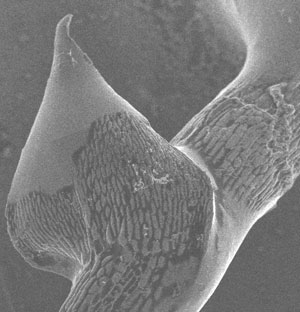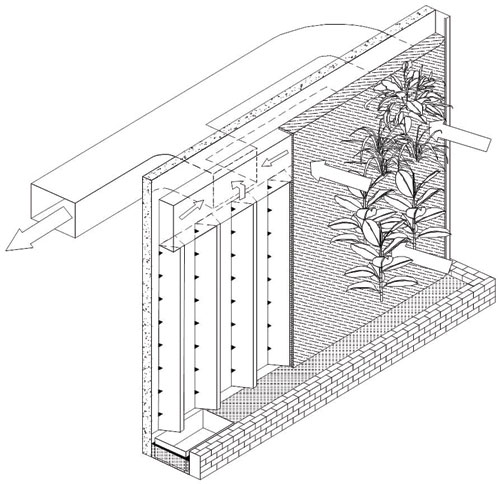Indoor Air Biofilters Deliver Clean Air Naturally
 |
Tiny microbes on the roots of plants use VOCs and other contaminants as a food source and break them down into harmless compounds. Image courtesy of Nedlaw Living Walls Inc. |
Just as ventilation can be realized through either mechanical or natural means, it is now possible to realize highly effective air filtration through natural processes that can be coupled with mechanical systems. The scientists at the University of Guelph and others since then have advanced the indoor air biofilter as a way to filter and clean indoor air naturally by installing a properly designed system based on plant-scapes inside the building. These systems employ a vertical hydroponic green wall (i.e. soil free and water based) containing a range of plants chosen specifically for use in the system. As a living air filter, it removes common indoor contaminants and improves the quality of the air. Indoor air is actively drawn through the green wall of plants, activating highly specialized, natural, biological processes to break down pollutants into their benign components of water and carbon dioxide. Clean, cool air is then distributed throughout the space by the mechanical ventilation system.
The indoor air biofilter system works by employing technology that is an adaptation of two separate industrial processes:
Biofiltration. In this process, a contaminated air or water stream is passed through a biologically active substrate where beneficial microbes use the pollutants—such as VOCs—as their food source. Nothing accumulates within the biofiltration system, however, since microbes degrade the contaminants into their benign constituents of carbon dioxide (CO2) and water.
Phytoremediation. This process has traditionally used green plants to facilitate the recovery of contaminated soils, a process typically used to clean-up contaminated brownfield sites. Using this same fundamental technology, plants can be indirectly involved in cleaning up contaminated indoor air by assisting in the growth and effectiveness of the beneficial microbes and creating the environment where they can thrive.
Using these processes, the indoor air biofilter can be thought of as a system of exposed plants that are integrated within a building and appear as a vertical hydroponic wall. Behind the scenes, a pump constantly circulates water from a reservoir at the base to the top of the wall. The water then flows down the wall through a porous synthetic root medium in which the plants are rooted. Air from the occupied space is actively drawn through the plant wall by either the HVAC system or onboard fans and then returned to the occupied space. As the dirty air from the space comes in contact with the growing (rooting) media, contaminants move into the water phase where they are broken down by the beneficial microbes growing on the roots and other surfaces in the growing media.
It is important to make a distinction here. The indoor air biofilter works because of the combination of all parts of the system described. Potted plants in a space are not capable of achieving the same or even similar results. The reason is because the removal of air contaminants is accomplished not by the leafy parts of the plants but by microbes that exist on the roots. In potted plants, the roots are obviously contained in soil which has little or no exposure to the air. Further, the pot itself is impermeable meaning that air will not flow through the sides of the pot. Even if it did, it would not likely be able to flow through the soil so it would never reach the roots or the microbes that could do the job of cleaning the air. Therefore, while potted plants may absorb some small amount of carbon dioxide and replace it with oxygen through photosynthesis, they will have little other impact on indoor air quality. And they will certainly not filter out contaminants.
| UNIVERSITY OF GUELPH HUMBER |
Built: May 2004 The biofilter measures 10 m wide and 16 m high for a total area of approximately 160 m². The largest single indoor air biofilter constructed at the time, it is fully integrated into the building air handling system and capable of delivering 40,000 CFM. It is supplied with natural light and supplemented with architectural lighting, and contributed towards the building receiving a 2005 award of excellence from the Royal Architecture Institute of Canada. |
Green Benefits of Indoor Air Biofilters
Indoor air biofilters provide a full range of contributions toward greening a building. In addition to improving the aesthetics and the physical environments of the facilities in which they are installed, they also help building owners improve the quality of the air for the occupants.
The first contribution is the ability of an indoor air filter to break down VOCs through the biofiltration process. In controlled laboratory studies, these systems have been shown to remove up to 90 percent of VOCs in a single pass. Real world testing in actual buildings shows some expected variation from ideal laboratory conditions, but they have still been measured at impressively high VOC removal rates. The process for determining this actual performance involves using sensors to measure the presence of VOCs in the ambient air that is entering a biofilter and similarly measuring the air that is exhausted from the biofilter. Testing using this process was undertaken at a dozen different locations representing different building types in both summer and winter conditions. The results of ongoing sampling showed that the levels of VOCs measured in the indoor ambient air could vary widely throughout the day and between buildings. As that air passed through the 12 indoor air biofilters tested, they were all found to remove VOCs but the rate of removal ranged from a full 100 percent removal down to less than 50 percent in some cases. The average removal rate across all 12 systems was about 85 percent overall with a typical 20 percent variation. Equally important, the testing found that air leaving the biofilter was not significantly different from outside “fresh” air when comparing the ambient parts per billion (ppb) of VOCs in each. In essence, the indoor air biofilter was found to be transforming the indoor air to the quality of fresh outdoor air in terms of VOC content.
 |
The schematic make up of an indoor air biofilter Image courtesy of Nedlaw Living Walls Inc. |









